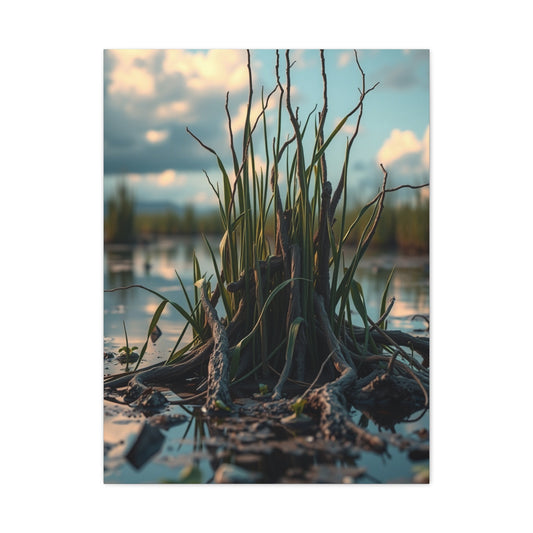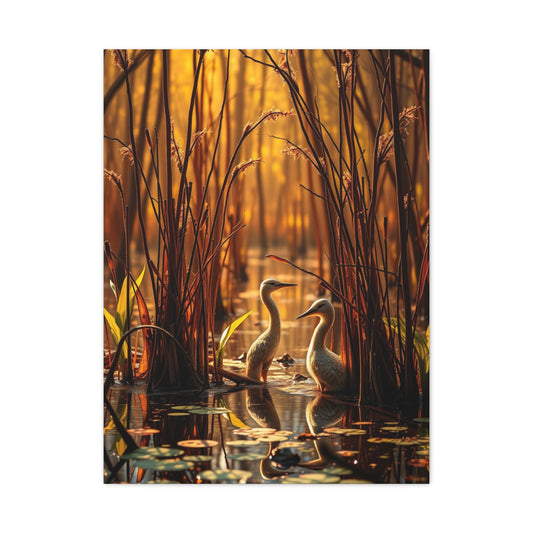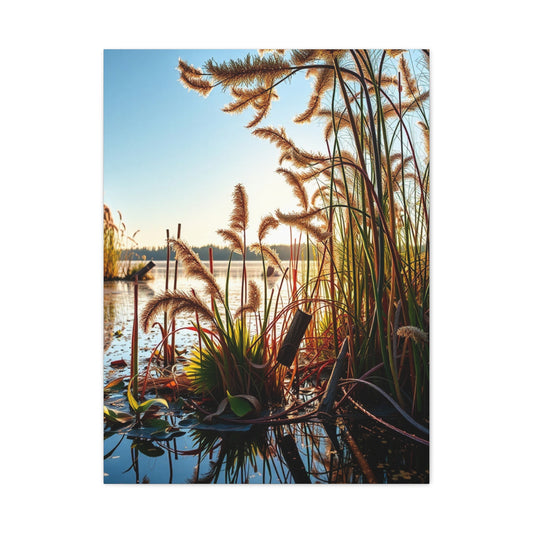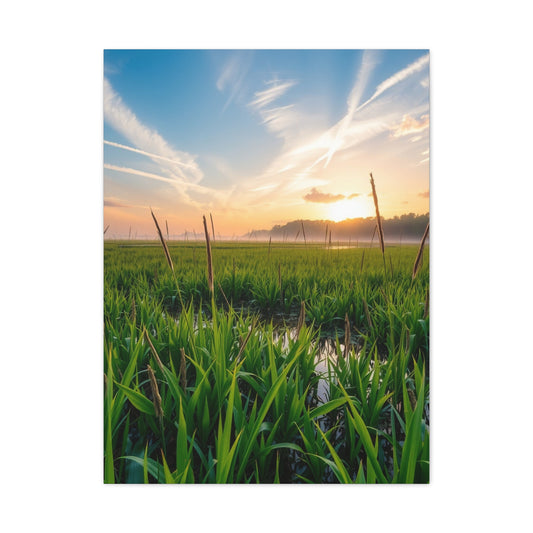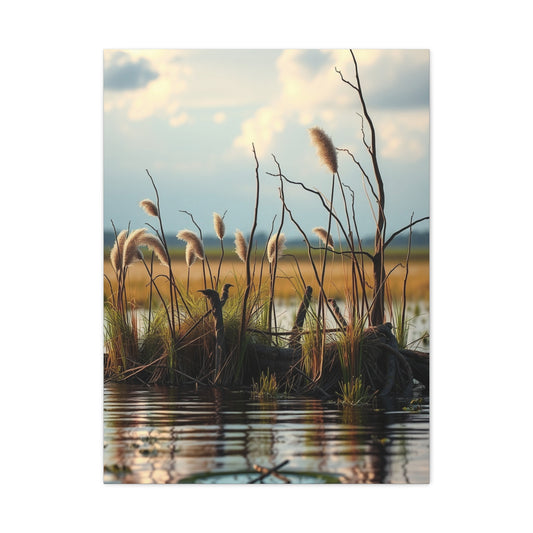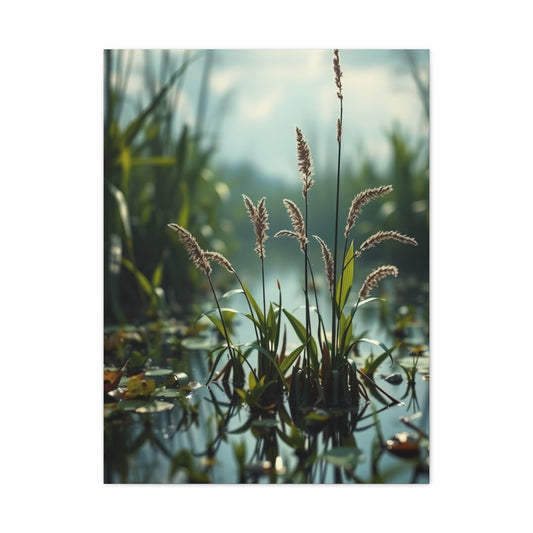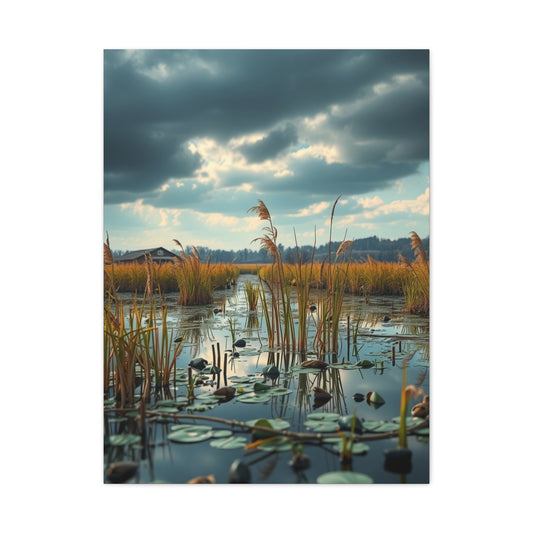Moody, Mystical, and Magical: Discover Marsh and Swamp Wall Art
The mystique and serene beauty of marshlands and wetland environments have captivated artists and interior designers for generations. These unique ecosystems, with their ethereal mists, towering cypress trees draped in Spanish moss, and reflective waters teeming with wildlife, offer an inexhaustible source of inspiration for creating stunning wall décor that transforms any living space into a tranquil sanctuary.
Wetland-themed artwork possesses an inherent ability to evoke feelings of peace, contemplation, and connection with the natural world. The subdued color palettes found in these environments - ranging from deep emerald greens and rich ochres to soft grays and muted browns - create a sophisticated and calming atmosphere that complements virtually any interior design scheme. Whether you're drawn to the dramatic shadows cast by ancient bald cypresses or the delicate interplay of light filtering through morning fog across still waters, marsh and wetland imagery provides endless possibilities for creating compelling visual narratives within your home.
The popularity of nature-inspired interior design has surged dramatically in recent years, with homeowners increasingly seeking ways to incorporate elements of the natural world into their living spaces. This biophilic design movement recognizes the profound psychological benefits of surrounding ourselves with representations of nature, and wetland artwork serves as a particularly effective means of achieving this connection. The organic shapes, natural textures, and earth-toned color schemes inherent in marsh imagery create a sense of groundedness and tranquility that can help reduce stress and promote overall well-being.
Contemporary artists working in various mediums have embraced the challenge of capturing the ephemeral beauty of wetland environments, producing works that range from photorealistic representations to abstract interpretations that focus on the emotional essence of these landscapes. Photography enthusiasts have discovered that marshlands offer exceptional opportunities for capturing dramatic lighting effects, particularly during the golden hours of dawn and dusk when mist rises from the water's surface and creates an almost otherworldly atmosphere.
The versatility of wetland-themed artwork makes it suitable for a wide range of interior design styles, from rustic cabin aesthetics to sleek contemporary spaces. Large-scale prints can serve as dramatic focal points in living rooms or dining areas, while smaller pieces can be grouped together to create engaging gallery walls that tell a cohesive story about the beauty and diversity of wetland ecosystems. The key lies in understanding how to select, arrange, and present these pieces in ways that enhance rather than overwhelm your existing décor.
Wetland Scenes That Transform Your Living Space
The selection of appropriate wetland imagery for your walls requires careful consideration of both the specific characteristics of your space and the mood you wish to create. Different types of marsh scenes evoke distinct emotional responses and work better in certain environments than others. Understanding these nuances will help you make informed decisions about which pieces will have the greatest impact in your home.
Sunrise and sunset scenes over marshlands offer some of the most visually striking options for wall décor. These images typically feature dramatic skies painted in warm hues of orange, pink, and gold, reflected in still waters and silhouetted against the distinctive shapes of wetland vegetation. Such pieces work exceptionally well in spaces where you want to create a sense of warmth and energy, such as dining rooms or entryways where guests first encounter your home's aesthetic.
Misty morning scenes provide a completely different emotional register, emphasizing subtlety, mystery, and contemplation. These images often feature soft, muted colors and ethereal qualities that make them ideal for bedrooms, meditation spaces, or reading nooks where a sense of calm and introspection is desired. The gentle gradations of gray and blue found in foggy marsh scenes can help create a cocoon-like atmosphere that promotes relaxation and peace.
Wildlife-focused wetland artwork adds an element of vitality and natural drama to any space. Images featuring herons, egrets, alligators, or other marsh-dwelling creatures can serve as conversation starters while also celebrating the biodiversity of these remarkable ecosystems. Bird-watching enthusiasts particularly appreciate detailed depictions of waterfowl in their natural habitats, as these pieces allow them to bring their passion for ornithology into their living spaces.
Botanical studies of marsh plants and aquatic vegetation offer yet another avenue for incorporating wetland themes into your décor. Detailed illustrations or photographs of cattails, water lilies, cypress knees, or Spanish moss can add scientific interest and natural beauty to studies, home offices, or any space where intellectual curiosity is valued. These pieces often work particularly well when presented in series, creating educational displays that showcase the remarkable diversity of plant life found in wetland environments.
Abstract interpretations of marsh landscapes provide opportunities for more contemporary and artistic expressions of wetland themes. These pieces might focus on color, texture, and form rather than literal representation, allowing viewers to experience the essence of marshlands through purely visual means. Such artwork can bridge the gap between nature-inspired design and more modern aesthetic sensibilities, making it possible to incorporate wetland themes into even the most minimalist or contemporary spaces.
Atmospheric Marsh Wall Art Concepts
The creation of atmospheric marsh wall art relies heavily on understanding and utilizing the unique visual characteristics that make wetland environments so compelling. Successful pieces in this category typically emphasize mood and emotion over literal representation, using various artistic techniques to capture the intangible qualities that make marshes feel so distinctive and memorable.
Light plays a crucial role in creating atmospheric marsh artwork. The way sunlight filters through Spanish moss, creates dappled patterns on water surfaces, or illuminates morning mist rising from still waters provides endless inspiration for artists seeking to capture the ethereal qualities of these environments. Photographers working in wetlands often wait for specific lighting conditions that will enhance the mysterious and contemplative aspects of their subjects, understanding that the right light can transform an ordinary scene into something truly extraordinary.
Color temperature becomes particularly important when working with atmospheric marsh imagery. Cool blues and grays dominate during overcast conditions or in early morning light, creating a sense of tranquility and introspection. Warmer tones emerge during golden hour photography, when the low angle of the sun bathes everything in honey-colored light that emphasizes the romantic and nostalgic aspects of wetland landscapes.
Depth and layering contribute significantly to the atmospheric quality of marsh artwork. Successful pieces often feature multiple planes of visual interest, from foreground elements like cypress knees or fallen logs, through middle-ground vegetation, to background tree lines or distant horizons. This layering creates a sense of immersion that draws viewers into the scene and makes them feel as though they're actually standing in the marsh itself.
Water reflections add another layer of visual complexity and interest to atmospheric marsh artwork. Still waters act as natural mirrors, doubling the visual impact of trees, clouds, and wildlife while also creating opportunities for abstract patterns and compositions. Artists who understand how to work with reflections can create pieces that have both realistic appeal and abstract beauty, making them suitable for a wider range of interior design contexts.
Texture plays an increasingly important role in contemporary marsh artwork, with many artists incorporating techniques that emphasize the tactile qualities of wetland environments. Rough bark, smooth water surfaces, feathery Spanish moss, and spiky cattails all offer different textural elements that can be emphasized through various artistic media and techniques. These textural qualities help create artwork that engages viewers on multiple sensory levels, even when experienced purely visually.
Nature's Wetlands Captured in Artistic Expression
The artistic interpretation of wetland environments requires a deep understanding of both the ecological complexity of these systems and the visual techniques needed to communicate their beauty effectively. Successful wetland artists typically combine scientific knowledge with aesthetic sensitivity, creating works that are both beautiful and ecologically informed.
Seasonal variations in wetland environments provide rich subject matter for artists seeking to create comprehensive bodies of work. Spring marshes burst with new growth and migrating wildlife, offering bright greens and active compositions. Summer scenes emphasize lush vegetation and the full development of wetland plant communities. Autumn brings spectacular color changes as deciduous trees and grasses transform, while winter reveals the underlying structure of these environments, often creating stark and dramatic compositions.
The ecological diversity of wetland environments provides endless opportunities for artistic exploration. Different types of wetlands - from freshwater marshes and cypress swamps to coastal saltmarshes and prairie potholes - each have their own distinctive visual characteristics and wildlife communities. Artists who specialize in wetland subjects often develop expertise in particular types of wetlands, allowing them to capture the subtle differences that make each ecosystem unique.
Macro photography and detailed botanical illustration have emerged as particularly effective means of capturing the intricate beauty of wetland environments. Close-up studies of flower structures, insect life, or the patterns found in tree bark or water surfaces can reveal hidden worlds of beauty that might be overlooked in broader landscape views. These detailed studies work particularly well in intimate spaces where viewers can examine them closely and appreciate their technical excellence and scientific accuracy.
The temporal aspects of wetland environments - the way they change throughout the day and across seasons - present unique challenges and opportunities for artists. Some creators focus on capturing specific moments, such as the exact instant when morning mist begins to dissipate or the precise lighting conditions that occur just before a thunderstorm. Others create series that document changes over time, showing how the same location can appear completely different under varying conditions.
Conservation themes have become increasingly important in contemporary wetland art, with many artists using their work to raise awareness about the ecological importance of these threatened environments. Such pieces often combine aesthetic beauty with educational content, helping viewers develop a deeper appreciation for the ecological services that wetlands provide and the urgent need to protect these vital ecosystems.
Decorating Your Home with Wetland Prints
The successful incorporation of wetland prints into home décor requires careful attention to scale, placement, color coordination, and the overall narrative you wish to create within your living space. Unlike standalone art pieces, decorative prints must work harmoniously with existing furnishings, architectural features, and the daily life patterns of the inhabitants.
Scale considerations become particularly important when selecting wetland prints for different rooms and purposes. Large-scale panoramic prints of expansive marsh vistas work exceptionally well in spacious living areas where they can serve as dramatic focal points without overwhelming the space. These pieces often work best when given adequate breathing room, surrounded by neutral colors that allow the natural beauty of the wetland imagery to take center stage.
Smaller prints offer greater flexibility in placement and can be used to create intimate moments of natural beauty throughout the home. A series of smaller wetland images can be arranged to create gallery walls that tell stories about different aspects of marsh life, from wildlife studies to seasonal changes to detailed botanical illustrations. These arrangements work particularly well in hallways, staircases, or other transitional spaces where they can provide visual interest without competing with major furniture pieces.
Color coordination between wetland prints and existing décor requires understanding the natural color palettes found in these environments and how they interact with common interior design color schemes. The earth tones, muted greens, and soft grays typical of marsh imagery complement a wide range of interior colors, but the specific hues within your chosen prints should be carefully considered in relation to wall colors, furniture finishes, and textile selections.
Framing and presentation choices significantly impact how wetland prints integrate into your overall design scheme. Traditional wooden frames in natural finishes often complement the organic subject matter, while more contemporary metal or acrylic frames can help bridge the gap between nature imagery and modern design sensibilities. The choice of matting colors and widths also influences the overall impact of the pieces and their relationship to surrounding décor elements.
Lighting considerations become crucial when displaying wetland prints, as these images often rely heavily on subtle gradations of tone and color that can be easily compromised by inappropriate illumination. Natural light from windows can enhance the organic qualities of wetland imagery, but direct sunlight should be avoided to prevent fading. Artificial lighting should be chosen to complement the natural light qualities depicted in the artwork while providing adequate illumination for comfortable viewing.
Current Trends in Marsh-Themed Artwork
Contemporary trends in marsh-themed artwork reflect broader movements in interior design, environmental consciousness, and artistic expression. Understanding these trends can help you select pieces that feel current and relevant while also having lasting appeal that will continue to enhance your home for years to come.
Minimalist interpretations of marsh landscapes have gained considerable popularity, reflecting the broader trend toward simplified and uncluttered interior spaces. These pieces often focus on essential elements - perhaps a single heron silhouetted against a misty background or the simple geometric forms created by cattail stems against still water. The power of these works lies in their ability to suggest the complexity and beauty of wetland environments through carefully selected details rather than comprehensive representation.
Mixed media approaches have become increasingly common among artists working with wetland themes. These pieces might combine photography with painting, incorporate natural materials like actual moss or bark, or use digital manipulation to create dreamlike interpretations of marsh environments. Such works often appeal to collectors who appreciate both traditional craftsmanship and contemporary artistic innovation.
Environmental storytelling has emerged as a significant trend, with artists using their wetland imagery to communicate messages about climate change, habitat loss, and conservation needs. These pieces often work on multiple levels, functioning as beautiful décor while also serving as subtle reminders of our responsibility to protect these vital ecosystems. This approach resonates particularly well with environmentally conscious homeowners who want their décor choices to reflect their values.
Vintage and retro-inspired interpretations of wetland themes tap into nostalgia for simpler times and more direct connections with the natural world. These pieces might emulate the look of old nature photography, vintage field guides, or classic American landscape painting traditions. They often appeal to homeowners who appreciate the craftsmanship and attention to detail characteristic of earlier artistic periods.
Abstract and impressionistic approaches to wetland subjects allow artists to focus on the emotional and sensory aspects of these environments rather than their literal appearance. These pieces might emphasize color relationships, textural qualities, or the movement of light and atmosphere through wetland spaces. They offer opportunities for viewers to engage with wetland themes on a more purely aesthetic level while still maintaining connection to the natural world.
Wetland-Inspired Wall Décor Ideas
The creation of cohesive wetland-inspired wall décor schemes requires thoughtful planning and attention to how individual pieces work together to create unified and compelling visual narratives. Successful approaches often combine different types of wetland imagery, varying scales and formats, and complementary decorative elements that reinforce the natural theme.
Gallery wall arrangements offer excellent opportunities for creating comprehensive wetland displays that can accommodate pieces of varying sizes, subjects, and artistic styles. A well-planned wetland gallery wall might include landscape photographs, wildlife studies, botanical illustrations, and perhaps even three-dimensional elements like preserved specimens or natural materials. The key lies in creating visual rhythm and balance while maintaining thematic coherence.
Seasonal rotation strategies allow homeowners to keep their wetland-themed décor feeling fresh and responsive to natural cycles. Different sets of images can be rotated throughout the year, emphasizing the spring emergence of new growth, the lush abundance of summer, the dramatic color changes of autumn, or the stark beauty of winter wetland scenes. This approach also allows for the gradual expansion of wetland art collections over time.
Complementary decorative elements can enhance the impact of wetland wall art and help create more immersive natural environments within the home. Natural materials like driftwood, stones, or preserved plant specimens can be incorporated into display arrangements. Water features, whether actual fountains or simply blue glass elements, can reinforce aquatic themes. Lighting choices can be made to echo the soft, filtered quality of light often found in wetland environments.
Room-specific approaches recognize that different spaces within the home serve different functions and may benefit from different types of wetland imagery. Bedrooms might feature calm, misty morning scenes that promote relaxation, while dining areas could showcase more vibrant sunset or wildlife images that stimulate conversation. Home offices might benefit from detailed botanical studies that provide visual interest without being overly distracting.
Integration with existing collections and décor themes requires careful consideration of how wetland imagery will interact with other artistic and decorative elements already present in the space. Wetland themes often complement collections of pottery, natural materials, or other nature-inspired art. The goal is to create layered and interesting spaces that feel collected over time rather than designed all at once.
Creating Tranquil Spaces with Marsh Wall Art
The psychological and emotional impact of marsh wall art makes it particularly effective for creating tranquil spaces that serve as refuges from the stresses of daily life. Understanding how different types of wetland imagery affect mood and perception can help you select pieces that will most effectively serve your relaxation and restoration needs.
Color psychology plays a crucial role in the calming effects of marsh wall art. The muted greens found in wetland vegetation have been shown to have calming and restorative effects, while the blues and grays common in water and sky imagery can help lower blood pressure and reduce anxiety. These natural color palettes work particularly well in spaces intended for relaxation, such as bedrooms, reading nooks, or meditation areas.
Compositional elements within marsh artwork can also influence the sense of tranquility they create. Horizontal compositions, such as wide views across still waters, tend to have calming effects and can make spaces feel larger and more open. Vertical compositions, like tall cypress trees or cattail stands, can add dignity and grandeur to a space while still maintaining peaceful qualities.
The scale and placement of marsh art within tranquil spaces requires careful consideration of viewing distances and sight lines. Pieces intended for close contemplation, such as detailed studies of wetland flora, should be positioned where they can be easily examined and appreciated. Larger landscape pieces work best when they can be viewed from comfortable seating areas where their calming effects can be fully experienced.
Layering different elements of marsh-themed décor can create more immersive and effective tranquil spaces. This might include combining wall art with natural materials, soft textiles in complementary colors, and perhaps even subtle sound elements like water features or nature recordings. The goal is to create multi-sensory experiences that fully transport occupants from the stresses of daily life into the peaceful world of the marsh.
Personal connection and meaning enhance the effectiveness of marsh art in creating tranquil spaces. Pieces that relate to specific locations or experiences often have greater emotional resonance and calming power. This might include artwork depicting marshes you've visited, species you've observed, or landscapes that hold special significance in your life story.
Wetland Vibes in Modern Home Décor
The integration of wetland themes into contemporary home design requires a sophisticated understanding of how natural imagery can be adapted to work within sleek, minimalist, and often urban living environments. Modern interpretations of marsh and wetland art often emphasize clean lines, simplified compositions, and sophisticated color palettes that complement contemporary furnishings and architectural details.
Contemporary artistic treatments of wetland subjects often focus on essential elements and geometric relationships rather than detailed representation. These might include simplified silhouettes of wading birds, abstract interpretations of water patterns, or minimalist compositions that capture the essence of marsh environments through carefully selected shapes and colors. Such approaches allow homeowners to incorporate nature themes without compromising modern aesthetic sensibilities.
Material choices in modern wetland-themed décor often emphasize sleek presentations that complement contemporary interiors. This might include artwork printed on metal, acrylic, or other modern materials that create different visual effects from traditional paper or canvas prints. Glass and perspex mounting systems can create floating effects that emphasize the ethereal qualities often found in marsh imagery.
Monochromatic and limited color palette approaches can help wetland art integrate more seamlessly into modern spaces that emphasize neutral colors and clean lines. Black and white photography of marsh scenes can be particularly effective in contemporary settings, emphasizing form, composition, and tonal relationships while maintaining the emotional connection to natural environments.
Scale relationships in modern spaces often call for larger, more dramatic presentations of wetland imagery. Large-format prints or even wall-sized installations can serve as major design elements that define and anchor modern living spaces. These oversized presentations can create powerful focal points while still maintaining the calming and restorative qualities associated with wetland imagery.
Digital and interactive elements represent emerging trends in contemporary wetland-themed décor. This might include digital displays that can show rotating collections of marsh imagery, interactive elements that respond to movement or touch, or augmented reality features that can add depth and animation to static artworks. These technological approaches appeal to homeowners who appreciate innovation while still wanting to maintain connections with the natural world.
Marshland Murals and Large Format Art
Large-scale marshland murals and oversized art installations offer unique opportunities to create immersive environmental experiences within interior spaces. These dramatic presentations can transform entire walls or rooms, creating the sensation of being surrounded by wetland environments and maximizing the psychological and aesthetic benefits of nature-themed décor.
Wall mural design for marshland themes requires careful attention to perspective, scale, and continuity across large surfaces. Successful murals often create the illusion of depth and distance, using techniques like atmospheric perspective to suggest vast wetland vistas that extend far beyond the confines of the room. The challenge lies in creating compositions that work effectively when viewed from various positions within the space and at different times of day under varying lighting conditions.
Photographic mural techniques have advanced significantly with improvements in digital printing and large-format reproduction capabilities. High-resolution photography of marsh environments can now be reproduced at wall-sized scales with remarkable detail and color fidelity. These photographic murals can create almost window-like effects, making interior spaces feel more connected to outdoor environments and providing constant visual access to the calming beauty of wetland landscapes.
Hand-painted mural approaches offer unique advantages in terms of customization and artistic interpretation. Skilled muralists can adapt marsh imagery to specific architectural features, incorporate personal elements or local species, and create seamless integrations with existing room features. Hand-painted murals also offer opportunities for ongoing modification and seasonal updates that can keep the artwork feeling fresh and responsive to changing needs.
Removable and temporary mural solutions have become increasingly popular for renters or homeowners who want the impact of large-scale marsh imagery without permanent modification to their walls. High-quality vinyl prints and other removable materials can provide impressive results while maintaining flexibility for future changes. These solutions are particularly valuable in rental properties or homes where décor needs may change frequently.
Integration with architectural features can enhance the effectiveness of marshland murals and large-format art. Careful consideration of room proportions, ceiling heights, window placement, and existing architectural details can help create murals that feel like natural extensions of the space rather than mere decorations. This might include wrapping murals around corners, incorporating them into alcoves, or designing them to interact with lighting fixtures or other room features.
Selecting Wall Art for Nature Enthusiasts
Nature enthusiasts often have specific knowledge and passionate interests that influence their preferences for wetland wall art. Understanding the different types of nature appreciation and how they translate into artistic preferences can help in selecting pieces that will have maximum appeal and personal meaning for these discriminating viewers.
Scientific accuracy and ecological authenticity matter significantly to serious nature enthusiasts. Artwork that accurately depicts species, habitats, and ecological relationships will be more meaningful and satisfying to viewers who understand these subjects intimately. This might include ensuring that bird species are shown in appropriate habitats, that plant communities are accurately represented, or that seasonal timing is correctly portrayed in wildlife scenes.
Rare and unusual subject matter often appeals to nature enthusiasts who have extensive knowledge of common species and environments. Artwork featuring less common wetland species, unusual behavioral moments, or rare ecological phenomena can provide the kind of unique content that speaks to advanced nature lovers. This might include nocturnal marsh scenes, images of unusual weather conditions, or documentation of rarely observed animal behaviors.
Educational and interpretive elements can add value for nature enthusiasts who appreciate learning opportunities. Artwork that includes scientific names, ecological information, or conservation messages can serve dual purposes as both decoration and education. Field guide-style presentations or museum-quality educational displays can be particularly appealing to this audience.
Personal observation and experience often influence the artwork preferences of serious nature enthusiasts. Pieces that depict locations they've visited, species they've observed, or experiences they've had can have special resonance and meaning. Custom artwork based on personal photographs or field sketches can create unique pieces that combine artistic quality with personal significance.
Collector-quality considerations become important for nature enthusiasts who view artwork as long-term investments. This includes attention to artistic reputation, print quality, edition sizes, and documentation. Limited edition prints by recognized wildlife artists or photographers often appreciate in value while providing lasting enjoyment and pride of ownership.
Wetland Color Palettes in Interior Design
The sophisticated color palettes found in wetland environments offer interior designers and homeowners rich opportunities for creating harmonious and nature-inspired living spaces. Understanding how these natural color relationships work and how they can be translated into interior design applications requires both artistic sensitivity and practical knowledge of color theory.
Earth tone foundations form the basis of most wetland-inspired color schemes. These include the rich browns of cypress bark and muddy substrates, the varied grays of weathered wood and misty skies, and the deep greens of aquatic vegetation. These foundational colors provide stability and grounding for interior spaces while creating connections to the natural world. They work particularly well as base colors for walls, flooring, or major furniture pieces.
Water-inspired blues and gray-greens add freshness and movement to wetland color palettes. These colors can range from the pale blue-grays of early morning mist to the deeper blue-greens of shadowed water beneath overhanging vegetation. In interior applications, these colors work effectively as accent colors in textiles, artwork, or decorative accessories. They can also serve as main colors in spaces where a sense of coolness and tranquility is desired.
Seasonal accent colors provide opportunities for variation and interest within wetland-inspired interior schemes. The bright greens of spring growth, the warm golds and oranges of autumn foliage, or the stark whites and silvers of winter scenes can be incorporated through changeable elements like pillows, artwork, or floral arrangements. This approach allows interior spaces to reflect the natural cycles of wetland environments while maintaining year-round coherence.
Light and shadow considerations significantly influence how wetland color palettes work in interior spaces. The filtered, diffused light characteristic of many wetland environments suggests interior lighting approaches that emphasize softness and subtlety rather than harsh illumination. This might include layered lighting schemes that create pools of warm light and areas of gentle shadow, mimicking the dappled light conditions often found beneath cypress canopies.
Texture and finish interactions with wetland color palettes can enhance their natural authenticity and visual interest. Matte finishes often work better than glossy ones for earth tones, as they more closely approximate the light-absorbing qualities of natural materials. Textured surfaces can add depth and visual interest while reinforcing the organic qualities of wetland-inspired color schemes.
Featured in Marsh Wall Prints
The diverse wildlife communities found in marsh and wetland environments provide endless subject matter for wall prints that can add vitality, interest, and educational value to interior spaces. Different types of wildlife imagery serve different decorative and emotional purposes, from creating dramatic focal points to adding subtle natural accents to existing décor schemes.
Bird life represents perhaps the most popular category of marsh wildlife art, with good reason. The elegant forms of herons, egrets, and other wading birds create naturally graceful compositions that work well in a variety of interior settings. These birds often serve as symbols of patience, grace, and connection to natural rhythms, making them particularly appealing for spaces intended for relaxation or contemplation. The variety of poses, lighting conditions, and compositional approaches possible with bird subjects provides extensive options for collectors and decorators.
Waterfowl imagery adds different qualities to marsh-themed wall art collections. Ducks, geese, and other swimming birds often appear in more dynamic compositions that emphasize movement, family groups, or seasonal migration patterns. These images can work particularly well in casual or family-oriented spaces where their more active and social qualities complement the room's function and atmosphere.
Amphibian and reptile subjects offer opportunities for more unusual and educational wall art choices. Frogs, turtles, snakes, and alligators each bring their own aesthetic qualities and symbolic associations to marsh-themed décor. Detailed close-up studies can reveal the intricate beauty of these often-overlooked creatures, while broader environmental shots can show their ecological roles within wetland communities.
Insect and invertebrate life, while less commonly featured, can provide fascinating subjects for marsh wall art. Dragonflies and damselflies create particularly appealing subjects with their delicate wings and jewel-like colors. These smaller creatures work well in detailed studies or macro photography that reveals hidden worlds of beauty within marsh environments.
Mammalian marsh residents like beavers, muskrats, or deer add different scales and storytelling opportunities to wildlife wall art collections. These subjects often work well in larger format pieces where their full forms and behaviors can be adequately portrayed. They can add warmth and relatability to marsh-themed décor while also highlighting the diversity of life supported by wetland ecosystems.
Rustic Wall Art for Cabin and Lodge Settings
Wetland and marsh imagery naturally complements rustic interior design styles, making it an ideal choice for cabins, lodges, and other settings that emphasize connection to outdoor recreational lifestyles. The key lies in selecting and presenting marsh art in ways that enhance rather than conflict with the rough-hewn, natural materials and informal atmospheres characteristic of these environments.
Material authenticity becomes particularly important in rustic settings. Artwork presentations should complement natural materials like wood, stone, and wrought iron rather than competing with them. This might include choosing frames made from reclaimed wood, barnwood, or other materials that echo the rustic architectural elements. Metal frames in bronze, copper, or iron finishes can also work well when they complement existing hardware and lighting fixtures.
Scale relationships in rustic spaces often favor larger, more dramatic presentations that can hold their own against substantial architectural elements like exposed beams, stone fireplaces, or log walls. Oversized prints or groupings of multiple pieces can create appropriate visual weight and impact in rooms with high ceilings or expansive wall surfaces.
Subject matter selection for rustic settings often emphasizes the more dramatic or adventurous aspects of wetland environments. Images featuring hunting or fishing scenes, dramatic weather conditions, or wildlife in action can complement the outdoor recreational themes common in cabin and lodge settings. The goal is to celebrate the excitement and challenge of outdoor experiences while maintaining the peaceful qualities that make marsh imagery so appealing.
Vintage and antique styling can enhance the timeless qualities desired in many rustic settings. This might include artwork that emulates the look of old field guides, vintage outdoor photography, or classic sporting prints. Sepia tones, aged paper effects, or deliberately weathered presentations can help new artwork feel like treasured heirlooms that have been part of the cabin for generations.
Lighting considerations in rustic settings often involve working with existing fixtures like lanterns, oil lamps, or firelight. Artwork should be selected and positioned to work effectively under these often-dim lighting conditions while still being clearly visible and appealing. Warm color temperatures and images with good contrast work particularly well in these challenging lighting environments.
Styling and Placement of Marsh Artwork
The effective styling and placement of marsh artwork requires careful consideration of viewing angles, lighting conditions, room functions, and relationships with other decorative elements. Professional-quality results depend on understanding both the technical aspects of art display and the psychological factors that influence how artwork is perceived and appreciated within living spaces.
Height and positioning guidelines for marsh artwork should take into account both optimal viewing distances and the specific characteristics of the imagery being displayed. Wildlife subjects often work best when positioned at eye level where details can be easily appreciated, while landscape pieces might be positioned slightly higher to create the sense of looking out toward distant horizons. The center point of artwork should generally be positioned between 57 and 60 inches from the floor for average ceiling heights.
Grouping and arrangement strategies can significantly enhance the impact of marsh artwork collections. Series of related images work well when arranged in grid patterns or flowing arrangements that echo natural formations. Mixing different sizes within grouped arrangements can create visual rhythm and prevent monotony, but care must be taken to maintain balanced compositions that feel intentional rather than random.
Relationship to furniture and room layouts affects both the visibility and impact of marsh artwork. Pieces positioned above seating areas should be large enough to maintain visual presence when viewed from normal seating positions. Artwork in dining areas should be positioned to be easily viewed and discussed during meals, while pieces in bedrooms should create calm focal points that support relaxation and rest.
Lighting design for marsh artwork should emphasize the natural qualities of the imagery while providing adequate illumination for comfortable viewing. Track lighting, picture lights, or strategically placed table lamps can enhance artwork without creating glare or harsh shadows. Natural light from windows can beautifully illuminate marsh imagery during daytime hours, but direct sunlight should be avoided to prevent fading.
Seasonal and rotational display strategies can keep marsh artwork feeling fresh and responsive to changing natural cycles. Different pieces can be emphasized during different seasons, or entire arrangements can be modified to reflect spring emergence, summer abundance, autumn transitions, or winter simplicity. This approach also allows for the gradual expansion of collections without overwhelming available wall space.
Wetland Aesthetic Wall Arrangements
Creating cohesive and visually compelling wetland aesthetic wall arrangements requires understanding principles of visual design, natural composition, and the specific qualities that make marsh and wetland imagery effective in interior settings. Successful arrangements often echo the organic patterns and relationships found in natural wetland environments while adapting them to the geometric constraints of interior architecture.
Organic grouping patterns that mirror natural formations can create more authentic and visually interesting arrangements than rigid geometric layouts. This might include asymmetrical groupings that echo the irregular patterns of cypress clusters, flowing arrangements that suggest the meandering paths of waterways, or layered compositions that reflect the complex vertical structure of wetland plant communities.
Scale relationships within wetland wall arrangements should create visual hierarchy and guide the viewer's attention through the composition. Larger pieces can serve as anchor points, with smaller supporting images arranged around them in ways that create visual flow and narrative development. The goal is to create arrangements that can be appreciated both as unified compositions and as collections of individual pieces.
Color harmony and contrast management help ensure that wetland wall arrangements work effectively within their interior contexts. While wetland imagery typically features harmonious natural color palettes, careful attention to the specific hues, saturations, and values within selected pieces can help create arrangements that feel balanced and intentionally composed rather than random or chaotic.
Textural variety and visual interest can be enhanced through careful selection of different artistic media, printing techniques, or presentation methods within wetland arrangements. This might include combining photography with illustrations, mixing different paper or canvas textures, or incorporating three-dimensional elements that add depth and tactile interest to primarily two-dimensional displays.
Negative space utilization becomes important in preventing wetland arrangements from feeling cluttered or overwhelming. The peaceful qualities of marsh environments should be reflected in arrangements that allow individual pieces breathing room while still creating unified compositions. This often requires resisting the temptation to fill every available wall surface with artwork.
Cozy Spaces Enhanced by Wetland Art
The inherently peaceful and contemplative qualities of wetland imagery make it particularly effective for enhancing cozy spaces where comfort, relaxation, and intimate scale are priorities. Creating these enhanced environments requires understanding how different types of marsh art can contribute to feelings of warmth, security, and connection to the natural world.
Intimate scale considerations become crucial when selecting wetland art for cozy spaces. Smaller prints often work better than large dramatic pieces in confined spaces, as they maintain appropriate proportion relationships and avoid overwhelming limited wall areas. Detailed studies that reward close examination can be particularly effective in reading nooks, window seats, or other small-scale environments where viewers will be positioned close to the artwork.
Warm lighting enhancement can significantly improve the effectiveness of wetland art in cozy settings. Soft, warm-toned lighting can bring out the golden and amber tones often found in marsh imagery while creating the kind of intimate atmosphere that makes small spaces feel inviting rather than cramped. Table lamps, floor lamps, or even candlelight can create lighting conditions that complement the peaceful qualities of wetland subjects.
Textile integration with wetland wall art can help create more unified and comfortable cozy environments. Throw pillows, blankets, or window treatments in colors that echo those found in marsh imagery can help tie rooms together while adding the soft textures that make spaces feel truly comfortable. Natural materials like linen, cotton, or wool work particularly well with wetland themes.
Conclusion:
Marsh and swamp wall art offers a unique and compelling way to bring the serene beauty and profound mystique of wetland environments into your living space. These artworks do more than simply decorate a room; they create immersive experiences that evoke feelings of peace, reflection, and a deep connection to nature’s rhythms. Through the ethereal mists, towering cypress trees, and delicate wildlife that characterize these ecosystems, wetland-themed art invites us to slow down and appreciate the quiet, magical moments that often go unnoticed in our fast-paced lives.
The subdued and earthy color palettes typical of marsh environments—ranging from deep greens and rich browns to soft grays and muted ochres—naturally foster a calming atmosphere that complements a wide variety of interior design styles. Whether you prefer the rustic charm of a countryside cabin or the sleek minimalism of a modern urban home, marsh and swamp artwork provides a versatile and sophisticated way to integrate nature’s tranquil beauty into your décor. Its organic shapes and textures help ground the space, creating a sense of balance and harmony that promotes well-being and reduces stress.
Furthermore, the wide range of artistic interpretations—from photorealistic depictions that capture every detail of the landscape, to abstract expressions that convey the emotional essence of these mysterious places—ensures that there is a perfect piece for every taste and setting. Whether you choose a dramatic sunrise over a misty marsh to energize a lively room, or a quiet foggy morning scene to enhance a bedroom’s peaceful ambiance, the key is to select artwork that resonates with the mood you wish to cultivate in your home.
The inclusion of wildlife and botanical subjects within wetland art adds additional layers of interest and narrative. Images of herons, alligators, or delicate aquatic plants not only celebrate the biodiversity of these habitats but also offer conversation starters and a touch of educational value for nature enthusiasts. Such pieces deepen our appreciation for these vital ecosystems and remind us of the delicate balance between human life and the natural world.
Ultimately, marsh and swamp wall art represents more than aesthetic appeal—it is a bridge between interior design and the natural environment, a source of inspiration and calm in our daily lives. By thoughtfully incorporating these artworks into your home, you create spaces that are not only visually stunning but also imbued with meaning and emotional depth. This connection to nature, artfully expressed through the mystery and magic of wetlands, enriches our living environments and nurtures our sense of well-being, making every room a tranquil sanctuary that invites both contemplation and wonder.


